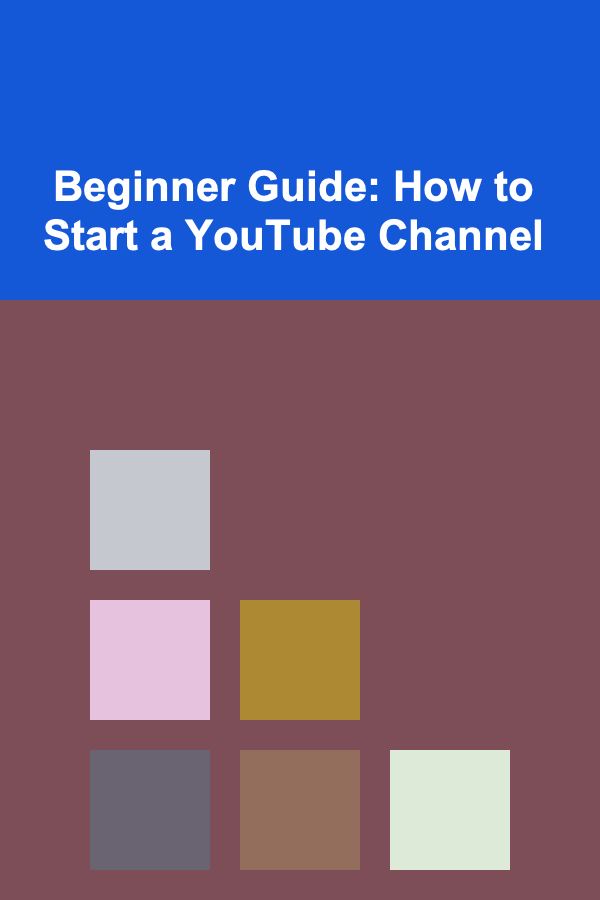
Beginner Guide: How to Start a YouTube Channel
ebook include PDF & Audio bundle (Micro Guide)
$12.99$8.99
Limited Time Offer! Order within the next:

Starting a YouTube channel can be an exciting and rewarding venture, whether you're looking to build a personal brand, share your passion, or even turn it into a full-time business. But the process can seem overwhelming if you're new to the platform. This comprehensive guide will walk you through everything you need to know to start a YouTube channel from scratch, covering the technical aspects, creative strategies, and practical tips to help you succeed.
Step 1: Understand Your Why
Before diving into the mechanics of setting up your channel, take a moment to understand why you want to start a YouTube channel in the first place. Defining your purpose will help guide your content strategy and ensure you remain motivated through the ups and downs.
- Passion Projects: Are you starting a channel to share your hobbies or interests, such as cooking, gaming, or tech reviews?
- Personal Branding: Are you an influencer, entrepreneur, or expert in a specific field looking to build a personal brand?
- Monetization: Are you aiming to make money through your channel, either through ads, affiliate marketing, or sponsorships?
Your "why" will shape the direction of your content and how you approach your audience.
Step 2: Choose Your Niche
With millions of channels and billions of videos on YouTube, it's crucial to define your niche. Focusing on a niche allows you to cater to a specific audience, increasing your chances of building a loyal community.
How to Find Your Niche:
- Passion and Interests: Consider the topics you're passionate about. Creating content about something you love will keep you motivated and make your videos more authentic.
- Audience Demand : Research what type of content is already popular. You can use tools like Google Trends , YouTube search , or VidIQ to identify trending topics.
- Competition: Analyze other channels in your niche. See what works, what doesn't, and where you can stand out.
Choosing the right niche not only helps you focus your content but also helps you connect with a community that shares your interests.
Step 3: Plan Your Content Strategy
Once you've chosen your niche, you need to create a content strategy. This includes deciding on the types of videos you will produce, how often you'll upload, and what kind of style or format you'll adopt.
Types of Content:
- Tutorials and How-To Videos: These types of videos provide value by teaching your audience something new, making them highly searchable.
- Product Reviews: If you're passionate about a specific type of product, reviewing them can be both fun and informative.
- Vlogs: A more personal, behind-the-scenes style where you share your daily life or experiences.
- Entertainment or Challenges: Videos focused on entertainment, trends, or viral challenges that engage viewers with fun content.
- Interviews and Collaborations: Work with other YouTubers or experts in your field to share unique perspectives.
Upload Frequency:
Consistency is key on YouTube. Whether you upload once a week or twice a month, stick to a schedule. Audiences appreciate knowing when they can expect new content, which can also help with YouTube's algorithm.
- Beginner Tip: Start with a manageable frequency, such as one video per week, and gradually increase it as you get comfortable.
Step 4: Set Up Your YouTube Channel
Now that you have a clear purpose and content strategy, it's time to set up your YouTube channel. Here's how to get started:
1. Create a Google Account
If you don't already have a Google account, you'll need one to create a YouTube channel. Visit YouTube and sign in using your Google credentials.
2. Create Your Channel
Once you're logged into YouTube, click on your profile icon in the top-right corner and select "Your Channel." From here, you can create a new channel, choosing between a personal or business name for your channel.
3. Customize Your Channel
Your YouTube channel is your online storefront, so make sure it looks appealing and professional.
- Channel Name: Choose a name that's memorable and aligns with your niche. It should be simple, easy to spell, and reflect your content.
- Channel Art : Design a banner (2560 x 1440 pixels) that communicates what your channel is about. Tools like Canva or Adobe Spark can help you create professional-looking graphics, even if you're not a designer.
- Profile Picture: Use a clear and high-quality image, preferably one that reflects your personal brand or niche.
- Channel Description: Write a concise description that explains who you are, what type of content you'll be uploading, and why people should subscribe to your channel.
4. Set Up Social Media Links
Link your social media accounts to your YouTube channel. This allows viewers to connect with you outside of YouTube and helps build your brand across platforms.
Step 5: Gather Your Equipment
Creating quality content doesn't always require expensive equipment, but having the right tools can make a big difference. Here's what you'll need to get started:
1. Camera
While a smartphone camera can be sufficient for beginners, a dedicated camera offers higher video quality. The Canon EOS M50 or the Sony ZV-1 are popular choices for beginners.
2. Microphone
Good audio quality is crucial. The Blue Yeti and Rode VideoMic are great options for different types of setups (desktop or camera-mounted).
3. Lighting
Proper lighting can make your videos look more professional. Consider using softbox lights, ring lights, or LED panel lights. The Neewer Ring Light Kit is a popular choice for beginners.
4. Editing Software
To edit your videos, you'll need software. Options vary based on your level of expertise and budget:
- iMovie (free for macOS users)
- DaVinci Resolve (free and professional-grade)
- Adobe Premiere Pro (paid, professional-grade)
If you're just starting, free software like Shotcut or Lightworks can be sufficient.
Step 6: Film Your First Video
When you're ready to film, keep these tips in mind:
1. Plan Your Shots
Even for a beginner, it's helpful to have a shot list or script to guide you through the video. This will reduce the need for retakes and ensure you stay on topic.
2. Frame Your Shots
Keep the camera at eye level, and make sure you're well-lit and in focus. If you're filming yourself, try to avoid distracting backgrounds.
3. Be Yourself
Viewers are more likely to connect with you if you're authentic. Speak naturally and don't worry about being perfect. The more comfortable you are, the more engaging your videos will be.
4. Record High-Quality Audio
Clear audio is just as important as clear video. If you're filming with a microphone, make sure it's positioned correctly, and avoid background noise as much as possible.
Step 7: Edit Your Video
Once you've filmed your video, it's time to edit it. The goal of editing is to make your video more engaging by removing mistakes, tightening up your narrative, and adding elements like music, text overlays, and transitions.
- Trim the Fat: Cut out long pauses, mistakes, or irrelevant content.
- Add Text and Graphics: Text can help clarify your message or emphasize key points.
- Background Music: Use royalty-free music to enhance the mood of your video.
- Call to Action: Don't forget to encourage viewers to like, comment, and subscribe.
Step 8: Optimize Your Video for Search
To get discovered on YouTube, optimizing your videos for search is essential. This process is known as YouTube SEO and involves making your videos more visible to YouTube's algorithm.
1. Video Title
Your title should be descriptive, catchy, and contain relevant keywords that viewers might search for. Keep it under 60 characters.
2. Description
Write a detailed video description that explains the content of your video. Include keywords naturally and add any relevant links.
3. Tags
Add relevant tags to help YouTube understand the context of your video. Use a mix of broad and specific tags.
4. Thumbnail
Create a custom thumbnail that grabs attention and entices viewers to click on your video. Thumbnails should be 1280 x 720 pixels and visually represent the content of the video.
5. Closed Captions
Adding captions or subtitles to your videos can make them more accessible and help them rank better in search.
Step 9: Publish and Promote Your Video
After uploading your video, it's time to promote it! Share your video on your social media platforms, email list, and any other places where you can reach your target audience.
Engage with Your Audience
Respond to comments, ask for feedback, and encourage discussions around your videos. The more you engage with your viewers, the more likely they are to subscribe and share your content.
Step 10: Analyze and Improve
Once your channel is live, monitor your performance using YouTube Analytics. Look at metrics like watch time, audience retention, and click-through rates to understand what's working and where you can improve.
- Experiment: Try different types of videos, upload times, and formats to see what resonates most with your audience.
- Iterate: Continuously refine your content based on feedback and performance data.
Conclusion
Starting a YouTube channel is an exciting journey that requires passion, consistency, and a willingness to learn. By following the steps outlined in this guide, you'll be well on your way to creating content that resonates with your audience and helps you build a successful YouTube presence. Remember, success on YouTube doesn't happen overnight, so be patient, stay consistent, and most importantly, enjoy the process!
Reading More From Our Other Websites
- [Personal Care Tips 101] How to Promote Healthy Hair with Personal Care Tips
- [Home Renovating 101] How to Maximize Space with Clever Built-In Storage Solutions
- [Organization Tip 101] How to Set Up a Smooth Moving Process for Your Home
- [Home Holiday Decoration 101] How to Design a Stunning Rose Home Christmas Tree
- [Home Renovating 101] How to Plan Your Home Renovation Timeline
- [Home Maintenance 101] How to Maintain Your Septic System: A Comprehensive Guide
- [Personal Investment 101] How to Invest in Crowdfunding Projects for High-Reward Opportunities
- [Scrapbooking Tip 101] Travel Memories Made Easy: Designing Photo-Heavy Vacation Scrapbooks
- [Home Renovating 101] How to Make Your Home More Accessible with Simple Renovations
- [Home Budget 101] How to Make Your Home Budget More Flexible Without Losing Control

Engage, Empower, Energize: A Comprehensive Guide to Being the Ultimate Community Manager
Read More
How to Choose Lighting for Different Ceiling Heights
Read More
How to Clean and Maintain Your Home's Gutters Effectively
Read More
How to Create a DIY Indoor Obstacle Course for Kids
Read More
How to Implement a Referral Program for New Tenants
Read More
How to Store Outdoor Fitness Equipment Safely
Read MoreOther Products

Engage, Empower, Energize: A Comprehensive Guide to Being the Ultimate Community Manager
Read More
How to Choose Lighting for Different Ceiling Heights
Read More
How to Clean and Maintain Your Home's Gutters Effectively
Read More
How to Create a DIY Indoor Obstacle Course for Kids
Read More
How to Implement a Referral Program for New Tenants
Read More